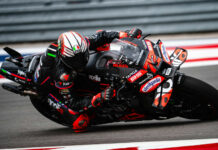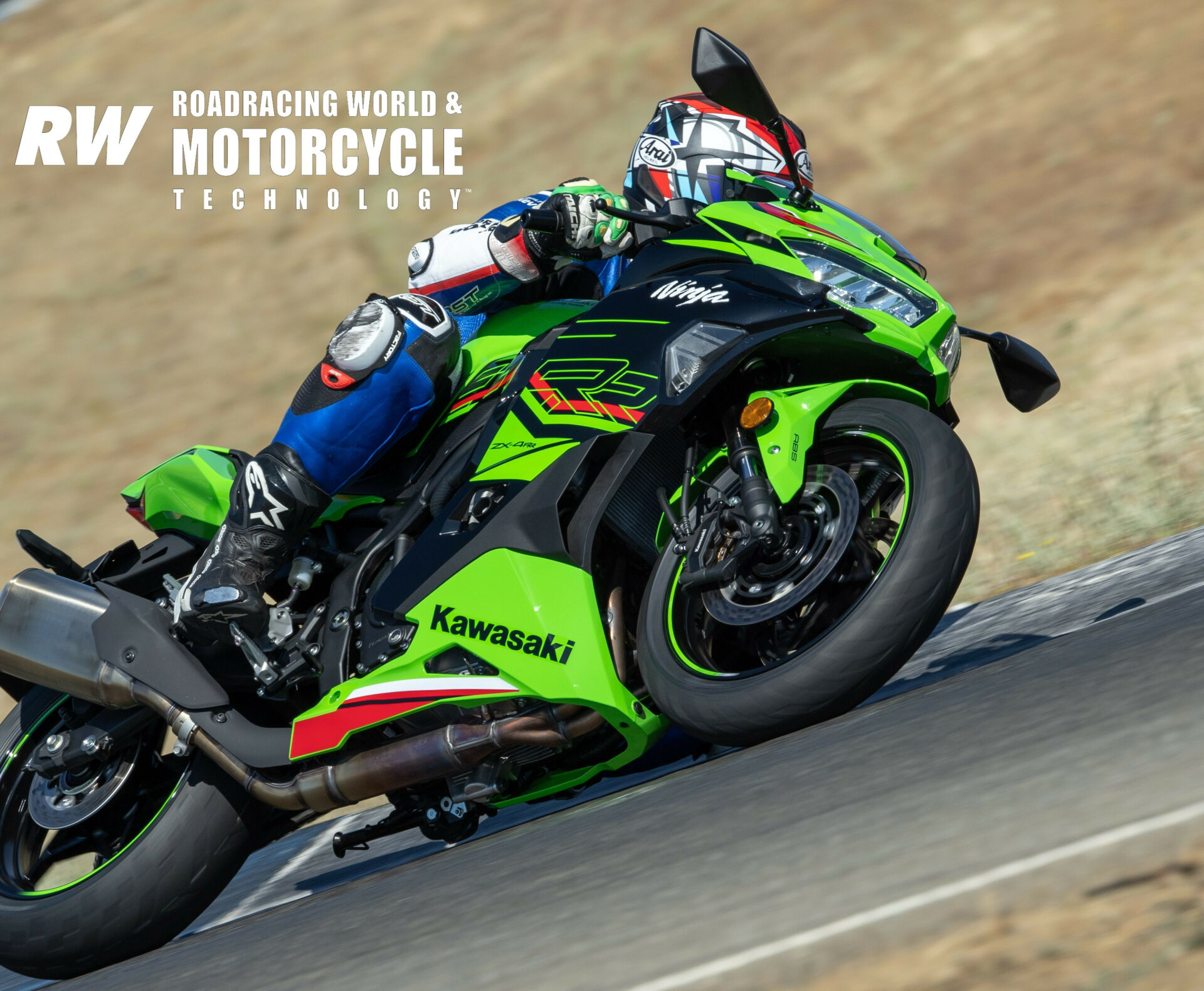Editorial Note: This article originally appeared in the August 2023 issue of Roadracing World & Motorcycle Technology magazine. Scroll all the way down to watch the video from the intro event at Thunderhill Raceway Park.
Intro: Kawasaki Ninja ZX-4RR
Screaming Fun!
By Chris Ulrich
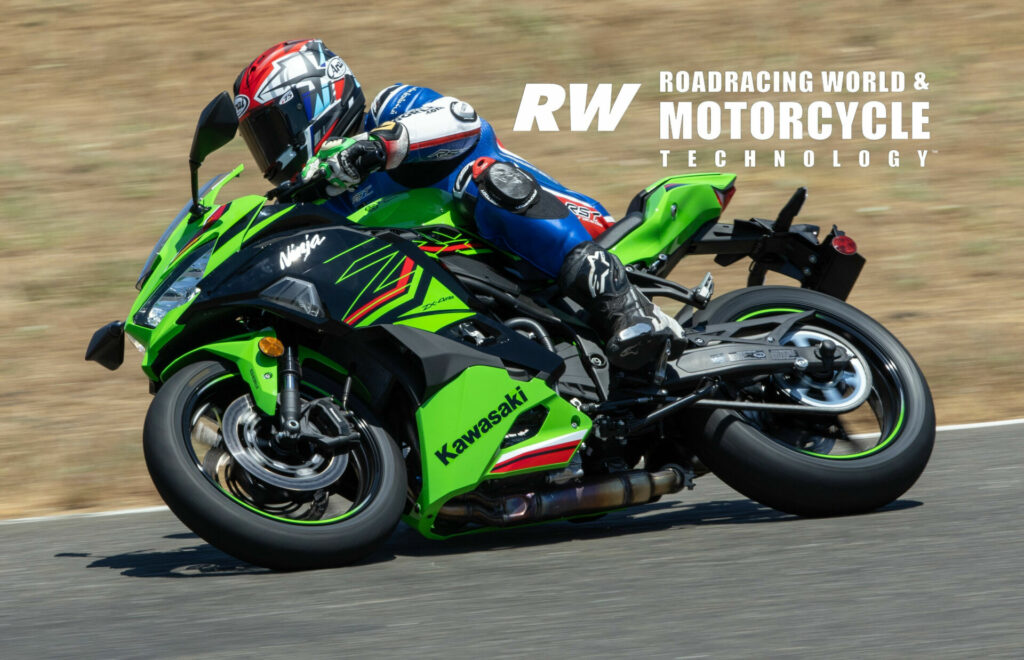
ZX-4RR global model paid off, with sales exceeding expectations. They’ll bring in more for 2024. The theme is more-usable power. Photo by Kevin Wing.
I was tucked in and flat-out with the throttle pinned as the revs climbed toward 15,000 rpm. I shifted into fourth gear before lifting my head and sticking my knee out just enough to create some drag as I turned into Thunderhill’s fast Turn 9 kink without breathing the throttle. It had taken me a couple of sessions and a few setting changes to get where I could go through the turn wide-open, but once I dialed in the bike’s set-up and my line, I could run through it at 107 mph lap after lap.
Ripping through corners flat out and picking up the throttle far earlier than sensible brought back memories of ripping around on my two-stroke Honda RS125 as a teenager. Except I was on a 400-class inline four-cylinder with a steel-tube chassis and street tires. The equipment was wildly different, but the technique used to hustle them around the racetrack is pretty close to being the same. And, sometimes, thinking (or over-thinking) about that progress, it’s mind-blowing how far mass-produced sportbikes have progressed over the years.
Why This Bike?
These days, high performance, small-displacement, four-cylinder sportbikes are not seen in the American market. Most of the motorcycles sold in the U.S. in this displacement category are price-point machines, so they cost less to build and buy, and have lower-performance engines, chassis, and assorted components. In the case of Kawasaki, its current entry-level model is the Ninja 400, powered by a Parallel Twin engine making less than 35 horsepower stock, and coming with conventional forks and a spindly, steel-tube chassis. Other products in the 400cc category—the twin-cylinder Yamaha YZF-R3 and the single-cylinder KTM RC390—share the same built-to-a-budget traits. A step up in terms of performance leads the consumer to the Yamaha YZF-R7, Kawasaki Ninja 650, and Suzuki SV650, but they all have a similar cost-down manufacturing directive and easy riding characteristics. None of them are pure-bred performance-oriented sportbikes.
Kawasaki is now changing the entry-level sportbike game with the new Ninja ZX-4RR, a 399cc Inline four-cylinder with a high-performance chassis, ride-by-wire throttle, and a premium electronics package, priced at $9,699. It’s a bold strategy, but brings another bike to the market with attainable performance for a regular rider and enough performance to entertain an experienced track-day or racing enthusiast. Kawasaki hopes that 15% of riders who purchase the ZX-4RR take it to the racetrack for track days or racing. If that happens, it would mean that owners are 40% more likely to take their bike to a racetrack than the next bike in Kawasaki’s sportbike line up, which is the 636cc ZX-6R.

Ninja ZX-4RR TECH
Comparing the new Kawasaki Ninja ZX-4RR to the other bikes in its displacement category doesn’t do it justice, because Kawasaki’s 40%-sized Superbike is a ripper! The Ninja ZX-4RR is essentially in a performance category of its own. Most of the tech was previously covered in the March issue, but let’s hit a few of the high points.
The ZX-4RR has the same look and feel as its larger displacement brothers. It has a low fuel tank and sleek bodywork with styling similar to the ZX-6R. A large ram-air scoop in the center of the upper fairing takes advantage of the high-pressure zone to send cold air to the airbox via a tube that snakes around the left fork leg. The aerodynamic tailsection is sleek.
The Ninja is powered by a liquid-cooled, 16-valve, double-overhead cam (DOHC) 399cc Inline-Four engine with a 57mm bore and a 39.1 mm stroke. Like other high-performance Kawasaki models, the ZX-4RR has machined combustion chambers and pistons that are cast to match. A friction-reducing molybdenum coating has been applied to the piston skirts to reduce friction. The valve pockets on top of each piston are wide to accommodate the two large (for its displacement) 22.1mm intake and two 19mm exhaust valves that are actuated by a set of forged hollow core camshafts. The valve angle is narrow, with the intakes set at 11.8 degrees from the cylinder centerline and exhausts at 13 degrees, so included valve angle is 24.8 degrees. The air -fuel mixture is fed to the ZX-4RR engine via a set of electronically-controlled 34mm throttle bodies. To improve intake efficiency, Kawasaki engineers worked to straighten the intake path from the throttle bodies to the valves. The compression ratio is a relatively-low 12.6:1, which allows the little Superbike to run on 87-octane fuel.
The engineers paid close attention to reducing engine mechanical losses and vibration. A lightweight flywheel decreases rotating mass. The crankshaft has been balanced to reduce vibration and the lightweight rods were put through a carburizing treatment to harden the steel and improve durability. An interesting add to the ZX-4RR is a deep sump oil pan, to maintain oil pressure during acceleration and deceleration.
The stainless-steel 4-2-1 exhaust system has 31.8mm head pipes, and all four are connected with cross tubes to balance out the exhaust speed and the volume flowing though each pipe. Kawasaki also placed the three catalyzers (required to meet strict emission standards) in the collector, so riders can easily add a slip-on muffler and still be compliant.

The Kawasaki Ninja ZX-4R has an electronics suite with features usually reserved for a 1000c flagship model. Headlining the electronic capabilities is the Kawasaki Traction Control (KTRC) system, which features three levels of traction control (TC), plus an off position. As usual, TC Mode 1 is the least intrusive, Mode 2 is in the middle, and Mode 3 delivers the most intervention. The ZX-4RR does not have an IMU, so interventions are based on wheel speeds and the rate of rpm change. Two Power Modes are available; Low reduces power and the throttle opening rate, while Full has a more aggressive throttle map. (After riding the bike for a day, I believe the Full power throttle map gives more throttle opening than the rider is actually asking for in some rpm ranges.) Four Riding Modes—Sport, Road, Rain, and Rider—are available, with Sport, Road, and Rain pre-loaded with appropriate settings for each. Selecting Rider Mode allows customizing the power delivery, by mixing the KTRC settings and Power Mode settings individually. Another premium feature is the addition of a Kawasaki Quickshifter system, which allows clutchless upshifts and downshifts.
Bluetooth capability has been added to the ZX-4RR to allow connection to Kawasaki’s Rideology app. The app allows the user to log rides, make Mode changes, receive messages on the dash, and receive important vehicle data. Obviously, the phone must be in range to run the real-time features like GPS.
Moving onto the chassis, Kawasaki engineers chose to use a steel-tube trellis main frame that connects to large swingarm pivot plates. Tubular steel is also used for the subframe, which is not removable from the main frame.
Kawasaki says the engineers used the ZX-10R as a reference when deciding on the relative engine position, pivot position, center of gravity, and castor angle. There’s not a direct correlation considering that the ZX-4RR has 23.5 degrees of rake and 96.5mm of trail while the ZX-10RR comes with 25 degrees of rake and 106.6mm of trail. To be fair, the smaller and lighter bike doesn’t need as much rake and trail, but it also explains why raising the front improved the front feel of the ZX-4RR (more on that later).
The ZX-4RR comes with Showa suspension fitted on both ends. At the front there are 37mm Showa Separate Function Fork-Big Piston (SFF-BP) inverted forks. The SFF-BP system separates the spring and damping functions of the fork legs. In the case of the ZX-4RR, the right fork leg has spring-preload adjustment only, while the left fork takes care of the damping duties. There is no damping adjustment on the front, but the ZX-4RR still performs well on track. The SFF-BF forks help reduce unit costs without sacrificing a ton of performance. A Showa Balance Free Rear Cushion Lite (BFRC-Lite) is used at the rear of the ZX-4RR. Unlike the forks, the BFRC has adjustable compression and rebound damping, plus spring pre-load adjustment. The shock mounts directly to a relatively long steel swingarm.
Stopping the ZX-4RR is a set of Kawasaki-labeled four-piston Nissin brake calipers that place a larger 32mm piston above a 30mm piston in each side. The calipers clamp onto a set of fully-floating 11.4-inch (290mm) rotors. To comply with Euro5 safety standards, the Kawasaki has a Nissin ABS unit that reads wheel speeds to determine slip conditions.
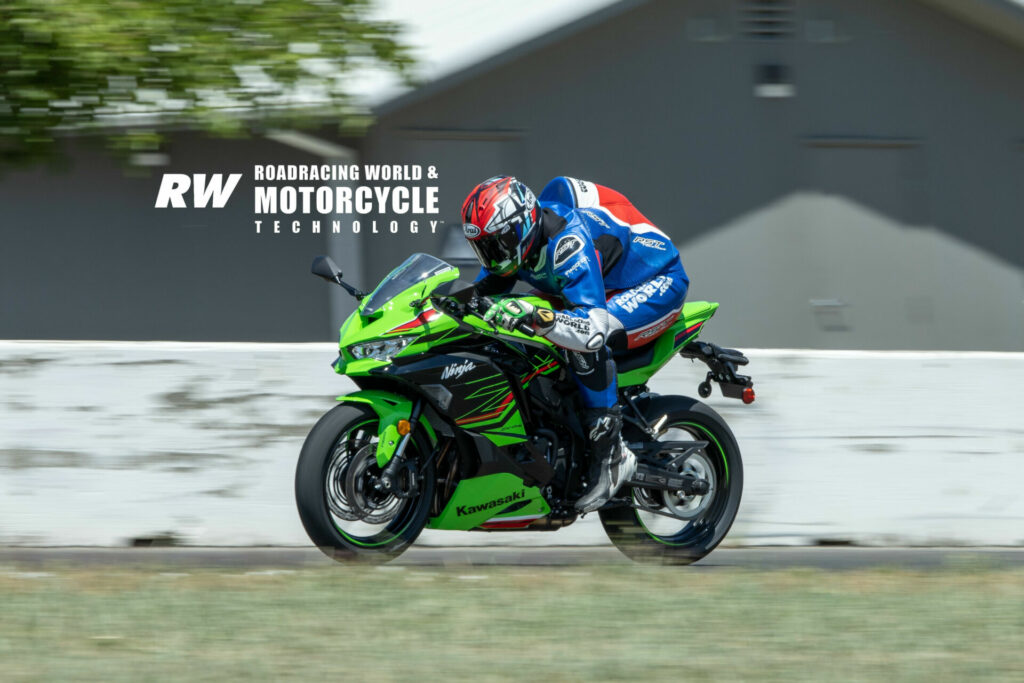
Spinning Laps On Track
I could tell the Ninja ZX-4RR was not a normal small-displacement, cost-down model a few corners into my first lap around Thunderhill Raceway Park. I fit on the bike pretty well; the rider triangle is sporty but not too cramped. The seat is firm and the fuel tank offers plenty of support.
I was comfortable right away on the ZX-4RR and that meant I quickly found the limit of the stock suspension settings. I was immediately into the bump stop on the front, and the rear setting didn’t allow me to finish the corners the way (and at the speed) I wanted to. While the stock suspension settings were too soft for me during the first session, I could still tell the ZX-4RR has a good engineering foundation. Meaning, the forks and head tube didn’t flex under heavy braking and turn-in; the bike didn’t wallow though the corners; and the rear did not twist and bind up on corner exits.
With the Electronic Throttle Valve (ETV) system Power Level set to Full and the Kawasaki Traction Control (KTRC) set on Level 1, the bike made good power, but was a little lazy during acceleration. Turning the KTRC off later in the day woke the ZX-4RR up. The quarter-size Superbike was happiest operating in a 4,500 rpm range from 10,000 to 14,500 rpm; the power nosed over as it approached the 15,000-rpm rev limit. (Early promotional materials said the ZX-4RR turned to 16,500 rpm, but that was before the EPA’s sound police stepped in.) Top speed is impressive for a 400; at Thunderhill, I was able to tag the rev limiter in fourth gear with a terminal speed of 121 mph just before letting off and dragging the front brake to set the front forks before peeling into Turn 1.
Moving to corner entry, the braking power and feel from the Nissin four-piston calipers and dual front brake discs were both great. But the behavior of the twist grip during deceleration was strange. I could feel the twist grip moving, mimicking the throttle plates, at certain points in the deceleration zone. This didn’t upset the chassis or add inputs and I eventually learned to ignore the movement, but it was alarming during the opening laps! The Kawasaki Quickshifter was good during acceleration, and each upshift was smooth and precise. But the ZX-4RR had a tendency to catch a false neutral downshifting between the 4th and 3rd-gear, so I had to be really deliberate on that downshift if I was using auto-blip—and I finally started using the clutch after my fifth missed shift. The throw is a bit long between those gears, so it takes care to get the shift. (The downshift between fourth and third is also a little dodgy on older Honda CBR1000RR and BMW S100RR models fitted with auto-blip, so it sometimes happens.)
With the first session over, I went to work on the chassis, taking advantage of the limited, yet effective, suspension adjustments available from the 37mm SFF-BP inverted forks and BFRC-Lite shock. My first change was adding 1.5mm of spring pre-load to the forks and shock. This change raised the bike, which improved cornering clearance and added support on both ends. As expected, I was then able to brake later at corner entry; front stability at the apex improved slightly; and the support at the rear helped the bike finish the corners. I then added a ¼-turn of compression and rebound damping to the Showa BFRC rear shock to improve support and slow down the pitch. This really helped me rotate the bike through the middle part of the corner. And increasing the rebound slowed the rate at which the shock returned, so braking stability was improved and the ZX-4RR was calmer on corner entry.

A bigger, more time-consuming change was adding 2mm of ride height to the front of the ZX-4RR by moving the tubes down in the triple clamps. Adding ride height to the front changed the weight bias, which made the Ninja more calm overall. The bike was then more stable on corner entry and at the apex, but the front sat a little high to really finish the corner. So, I then removed 1mm of preload from the front to balance out the changes, turned off the traction control, and rode the bike for the rest of the day with those settings.
Once the settings were in the zone, the Ninja ZX-4RR was really a lot of fun to ride. The chassis was stable in the low and mid-speed corners as well as in the fast sweepers at Thunderhill, and the relatively low overall weight and lack of crankshaft inertia made it easy to turn in, and nimble when I flicked side-to-side. It rotated and finished the corners well.
Rear grip wasn’t an issue; it shouldn’t be with around 65 horsepower at the rear wheel. I did have to constantly work on getting the throttle open as early as possible during the day. Convincing myself to grab a handful of throttle with a lot of lean angle is always an adjustment when coming off larger-displacement bikes!
Overall feel from the steel chassis was good. I had a big front-wheel slide going into Turn 5 late in the day, but I felt it start to go early and was able to slightly decrease brake pressure and dig my knee in to save myself from hitting the ground. At the rear, the feel from the chassis helped me gain the confidence to aggressively open the throttle mid-corner. Overall, Kawasaki got the rigidity balance of the chassis right, at least on the Dunlop Sportmax GPR-300 radial tires.
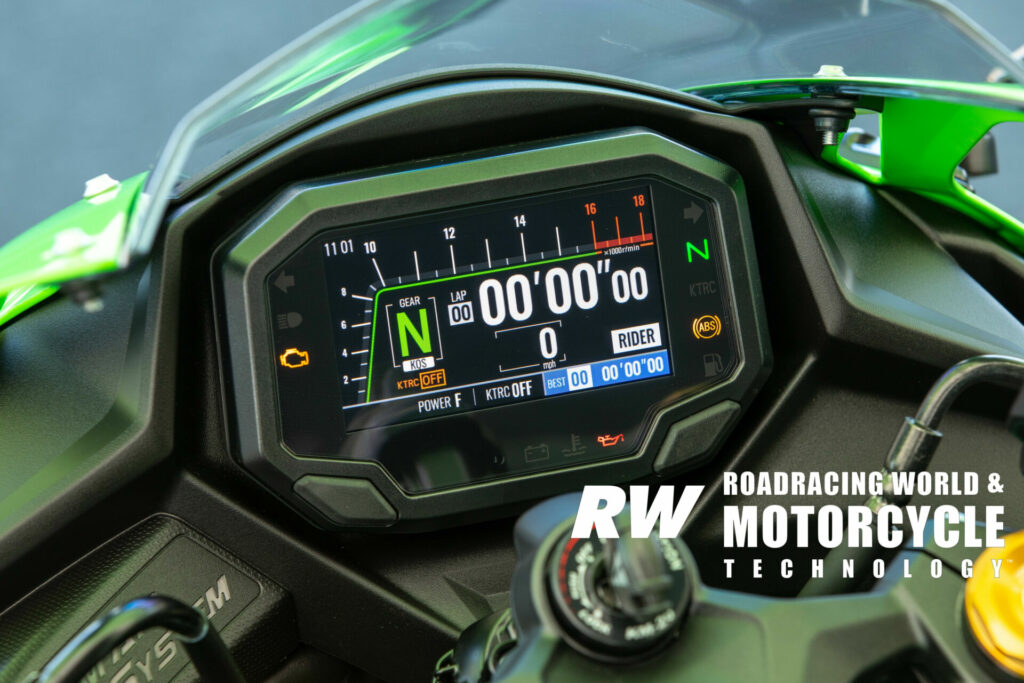
Engine performance improved with the ZX-4RR set to Full power with the KTRC turned off. Throttle response was more direct and the engine gained rpm more quickly during acceleration, and recovered rpm fast between shifts. Top speed was also improved and I saw 120 mph on the dash. I get it, electronic aids are a selling point, and the European standards require them in the name of safety. But in my opinion, a good rider doesn’t need traction control on a bike with less than 150-horsepower.
By the end of day, I’d completed over seven 30-minute sessions on the racetrack and it felt like I could keep riding for seven more sessions. I rode the Ninja ZX-4RR to the limit of the tires, chassis, and my ability all day. Yet I wasn’t fatigued mentally or physically, and I had a blast. That is the best part of smaller-displacement high-performance motorcycles: Getting into a rhythm, pounding out the laps, and having so much fun. The Kawasaki Ninja ZX-4RR has the chassis and engine performance to entertain a seasoned Superbike guy like me, but is mellow enough that anyone can ride it. Which makes it stand alone in its spot in the industry.

Specifications: 2023 Kawasaki Ninja ZX-4RR
Engine Configuration: Inline Four, 4-stroke,
Engine Displacement: 399cc
Engine Cooling: Liquid
Compression Ratio: 12.3:1
Combustion Chamber Design: Pentroof
Valves Per Cylinder: 4
Intake Valves Per Cylinder (Material): 2 (Stainless Steel)
Exhaust Valves Per Cylinder (Material): 2 (Stainless Steel)
Bore x Stroke: 57.0 mm x 39.1 mm
Connecting Rod Length (center-to-center): N.A.
Connecting Rod Material: Steel
Claimed Peak Horsepower: N.A.
Claimed Peak Torque: 26.5 lbs.-ft. @ 11,000 rpm
Engine Redline: 15,000 rpm
Valve Angle (Included): 11.8 degrees Intake/ 13 degrees Exhaust
(24.8 degrees)
Combustion Chamber Volume: N.A.
Valvetrain Type: DOHC, Roller Chain Drive, Bucket
Tappets, Shim-under-bucket Lash Adjustment
Valve Adjustment Interval: 15,000 miles
Intake Valve Diameter: 22mm
Exhaust Valve Diameter: 19mm
Intake Valve Stem Diameter: N.A.
Exhaust Valve Stem Diameter: N.A.
Intake Valve Maximum Lift: N.A.
Exhaust Valve Maximum Lift: N.A.
Intake Valve Timing:
Open BTDC: 23 degrees
Closed ABDC: 63 degrees Duration: 266 degrees
Exhaust Valve Timing:
Open BBDC: 55 degrees
Closed ATDC: 25 degrees
Duration: 260 degrees
Valve Timing Measurement Point (lift): 0.3mm
Fuel Delivery System: Keihin Digital Fuel Injection
Throttle Body Venturi Size: 34mm
Air Filter Type: Pleated Paper
Exhaust System Type (Material): 4-2-1 (Stainless Steel)
Ignition System: Digital
Rider Aids:
IMU: No Traction Control: 3 Levels, Plus Off
Slide Control: No
Wheelie Control: No
ABS: Yes (Nissin ABS Unit)
Quickshifter: Kawasaki Quick Shifter Up/Down (KQS)
Ride Modes Available: Rain, Road, Sport, Rider
Lubrication System: Wet Sump
Oil Capacity: 3.8 quarts (3.6 liters)
Fuel Capacity: 4.0 gallons (15.1 liters)
Transmission Type: Cassette, 6-speed, Constant Mesh
Clutch Type: Multi-plate, Wet, Back-torque limiting,
With Acceleration Assist
Clutch Actuation System: Cable
Clutch Spring Type: Coil
Number of Clutch Springs: 3
Number of Clutch Plates: 14
Drive Plates: 8
Driven Plates: 6
Primary Drive: Gear (Straight-cut)
Primary Drive Gear Teeth (Ratio): 14/41 (2.029:1)
Final Drive Sprocket Teeth (Ratio): 14/48 (3.429:1)
Transmission Gear Teeth (Ratios):
6th: 28/27 (1.037:1)
5th: 30/26 (1.154:1)
4th: 32/24 (1.333:1)
3rd: 34/21 (1.619:1)
2nd: 37/18 (2.056:1)
1st 41/14 (2.929:1)
Transmission Overall Ratios:
6th: 7.21:1
5th: 8.03:1
4th: 9.27:1
3rd: 11.29:1
2nd: 14.30:1
1st: 20.38:1
Theoretical Speed In Gears At Redline:
6th: 153 mph
5th: 136 mph
4th: 118 mph
3rd: 97 mph
2nd: 77 mph
1st: 53 mph
Engine Speed At 60 mph: 5,880 rpm
Frame Design (Material): Trellis (Steel)
Rake/Trail: 23.5 degrees/ 3.8 inches (96.5mm)
Claimed Wheelbase: 54.33 inches (1,380mm)
Claimed Swingarm Length: 22.5 inches (573mm)
Seat Height: 31.5 inches (800mm)
Footpeg Height: 12.4 inches (315mm)
Handlebar Height: 33.7 inches (857mm)
Steering Stem to Seat Center: 26.4 inches (670mm)
Front Forks: Showa Inverted SFF-BP, Cartridge
Fork Tube Diameter: 37mm
Fork Adjustments:
Rebound Damping: None
Compression Damping: None
Spring Preload: 10-turn Range
Front Wheel Travel: 4.7 inches (120mm)
Rear Wheel Travel: 5.3 inches (134mm)
Rear Suspension Type: Showa BFRC-Lite Single Shock
Rear Shock Adjustments:
Rebound Damping: 3-turn Range
Compression Damping: 5-turn Range
Spring Preload: 10mm Range
Front Brakes: 290mm (12.2-inch) Dual Discs, 4-piston
Radial-Mount Nissin Monoblock Calipers
Rear Brake: 220mm (8.7-inch) Disc, Single-piston Nissin Caliper
Front Wheel: 3.50 x 17.0-inch Cast Aluminum Alloy
Rear Wheel: 5.50 x 17.0-inch Cast Aluminum Alloy
Front Tire: 120/70-ZR17 Dunlop Sportmax GPR-300 Radial
Rear Tire: 160/60-ZR17 Dunlop Sportmax GPR-300 Radial
Claimed Wet Weight: 415 pounds (188.2 kg)
Claimed Weight Distribution, Percentage: N.A.
GVWR 811 pounds (1,788 kg)
Overall Length: 78.3 inches (1,990mm)
Overall Width: 20.1 inches (765mm)
Overall Height: 43.7 inches (1,110mm)
Ground Clearance: 5.3 inches (135mm)
Suggested Retail Price: $9,699



